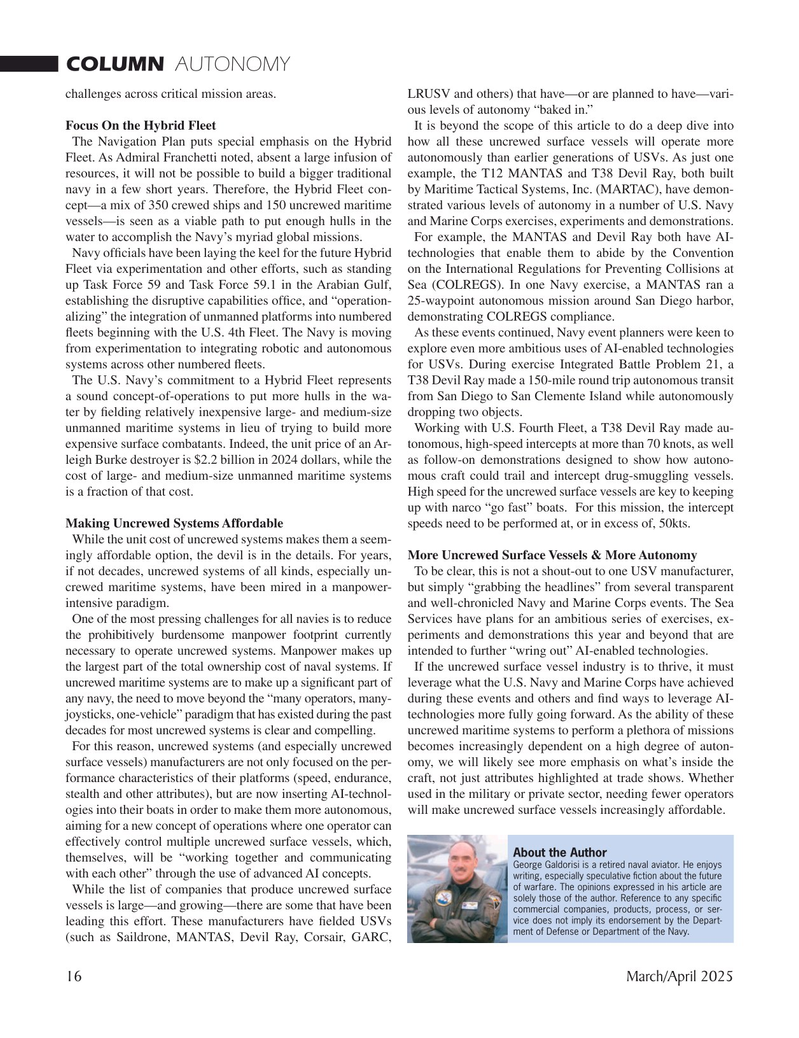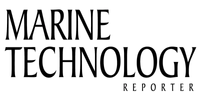
Page 16: of Marine Technology Magazine (March 2025)
Read this page in Pdf, Flash or Html5 edition of March 2025 Marine Technology Magazine
COLUMN AUTONOMY challenges across critical mission areas. LRUSV and others) that have—or are planned to have—vari- ous levels of autonomy “baked in.”
Focus On the Hybrid Fleet It is beyond the scope of this article to do a deep dive into
The Navigation Plan puts special emphasis on the Hybrid how all these uncrewed surface vessels will operate more
Fleet. As Admiral Franchetti noted, absent a large infusion of autonomously than earlier generations of USVs. As just one resources, it will not be possible to build a bigger traditional example, the T12 MANTAS and T38 Devil Ray, both built navy in a few short years. Therefore, the Hybrid Fleet con- by Maritime Tactical Systems, Inc. (MARTAC), have demon- cept—a mix of 350 crewed ships and 150 uncrewed maritime strated various levels of autonomy in a number of U.S. Navy vessels—is seen as a viable path to put enough hulls in the and Marine Corps exercises, experiments and demonstrations.
water to accomplish the Navy’s myriad global missions. For example, the MANTAS and Devil Ray both have AI-
Navy of? cials have been laying the keel for the future Hybrid technologies that enable them to abide by the Convention
Fleet via experimentation and other efforts, such as standing on the International Regulations for Preventing Collisions at up Task Force 59 and Task Force 59.1 in the Arabian Gulf, Sea (COLREGS). In one Navy exercise, a MANTAS ran a establishing the disruptive capabilities of? ce, and “operation- 25-waypoint autonomous mission around San Diego harbor, alizing” the integration of unmanned platforms into numbered demonstrating COLREGS compliance. ? eets beginning with the U.S. 4th Fleet. The Navy is moving As these events continued, Navy event planners were keen to from experimentation to integrating robotic and autonomous explore even more ambitious uses of AI-enabled technologies systems across other numbered ? eets. for USVs. During exercise Integrated Battle Problem 21, a
The U.S. Navy’s commitment to a Hybrid Fleet represents T38 Devil Ray made a 150-mile round trip autonomous transit a sound concept-of-operations to put more hulls in the wa- from San Diego to San Clemente Island while autonomously ter by ? elding relatively inexpensive large- and medium-size dropping two objects. unmanned maritime systems in lieu of trying to build more Working with U.S. Fourth Fleet, a T38 Devil Ray made au- expensive surface combatants. Indeed, the unit price of an Ar- tonomous, high-speed intercepts at more than 70 knots, as well leigh Burke destroyer is $2.2 billion in 2024 dollars, while the as follow-on demonstrations designed to show how autono- cost of large- and medium-size unmanned maritime systems mous craft could trail and intercept drug-smuggling vessels. is a fraction of that cost. High speed for the uncrewed surface vessels are key to keeping up with narco “go fast” boats. For this mission, the intercept
Making Uncrewed Systems Affordable speeds need to be performed at, or in excess of, 50kts.
While the unit cost of uncrewed systems makes them a seem- ingly affordable option, the devil is in the details. For years, More Uncrewed Surface Vessels & More Autonomy if not decades, uncrewed systems of all kinds, especially un- To be clear, this is not a shout-out to one USV manufacturer, crewed maritime systems, have been mired in a manpower- but simply “grabbing the headlines” from several transparent intensive paradigm. and well-chronicled Navy and Marine Corps events. The Sea
One of the most pressing challenges for all navies is to reduce Services have plans for an ambitious series of exercises, ex- the prohibitively burdensome manpower footprint currently periments and demonstrations this year and beyond that are necessary to operate uncrewed systems. Manpower makes up intended to further “wring out” AI-enabled technologies.
the largest part of the total ownership cost of naval systems. If If the uncrewed surface vessel industry is to thrive, it must uncrewed maritime systems are to make up a signi? cant part of leverage what the U.S. Navy and Marine Corps have achieved any navy, the need to move beyond the “many operators, many- during these events and others and ? nd ways to leverage AI- joysticks, one-vehicle” paradigm that has existed during the past technologies more fully going forward. As the ability of these decades for most uncrewed systems is clear and compelling. uncrewed maritime systems to perform a plethora of missions
For this reason, uncrewed systems (and especially uncrewed becomes increasingly dependent on a high degree of auton- surface vessels) manufacturers are not only focused on the per- omy, we will likely see more emphasis on what’s inside the formance characteristics of their platforms (speed, endurance, craft, not just attributes highlighted at trade shows. Whether stealth and other attributes), but are now inserting AI-technol- used in the military or private sector, needing fewer operators ogies into their boats in order to make them more autonomous, will make uncrewed surface vessels increasingly affordable.
aiming for a new concept of operations where one operator can effectively control multiple uncrewed surface vessels, which,
About the Author themselves, will be “working together and communicating
George Galdorisi is a retired naval aviator. He enjoys with each other” through the use of advanced AI concepts.
writing, especially speculative ? ction about the future of warfare. The opinions expressed in his article are
While the list of companies that produce uncrewed surface solely those of the author. Reference to any speci? c vessels is large—and growing—there are some that have been commercial companies, products, process, or ser- vice does not imply its endorsement by the Depart- leading this effort. These manufacturers have ? elded USVs ment of Defense or Department of the Navy.
(such as Saildrone, MANTAS, Devil Ray, Corsair, GARC, 16 March/April 2025
MTR #3 (1-17).indd 16 3/13/2025 4:54:05 PM

 15
15

 17
17
